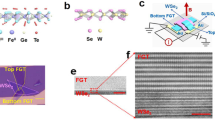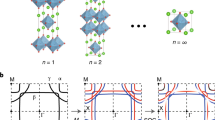Abstract
Transition-metal dichalcogenides such as WSe2 and MoS2 have electronic band structures that are ideal for hosting many exotic spin–orbit phenomena. Here we investigate the possibility to generate and modulate a giant Zeeman-type spin polarization in WSe2 under an external electric field. By tuning the perpendicular electric field applied to the WSe2 channel with an electric-double-layer transistor, we observe a systematic crossover from weak localization to weak anti-localization in magnetotransport. Our optical reflection measurements also reveal an electrically tunable exciton splitting. Using first-principles calculations, we propose that these are probably due to the emergence of a merely out-of-plane and momentum-independent spin splitting at and in the vicinity of the vertices of the WSe2 Brillouin zone under electric field. The non-magnetic approach for creating such an intriguing spin splitting keeps the system time-reversally invariant, thereby suggesting a new method for manipulating the spin degrees of freedom of electrons.
This is a preview of subscription content, access via your institution
Access options
Subscribe to this journal
Receive 12 print issues and online access
$209.00 per year
only $17.42 per issue
Buy this article
- Purchase on Springer Link
- Instant access to full article PDF
Prices may be subject to local taxes which are calculated during checkout





Similar content being viewed by others
Change history
19 August 2013
In the version of this Article originally published online, the equation in the first paragraph should have been: Ĥso = -μBσ · (p × E/2mc2). Also, throughout the Article, Beff should have appeared as a vector. These errors have been corrected in all versions of the Article.
References
Murakami, S., Nagaosa, N. & Zhang, S. C. Dissipationless quantum spin current at room temperature. Science 301, 1348–1351 (2003).
Ganichev, S. D. et al. Spin-galvanic effect. Nature 417, 153–156 (2002).
Lu, J. P. et al. Tunable spin-splitting and spin-resolved ballistic transport in GaAs/AlGaAs two-dimensional holes. Phys. Rev. Lett. 81, 1282–1285 (1998).
Dresselhaus, G. Spin–orbit coupling effects in zinc blende structures. Phys. Rev. 100, 580–586 (1955).
Bychkov, Y. A. & Rashba, E. I. Properties of a 2D electron gas with lifted spectral degeneracy. J. Exp. Theor. Phys. Lett. 39, 78–81 (1984).
Datta, S. & Das, B. Electronic analog of the electro-optic modulator. Appl. Phys. Lett. 56, 665–667 (1990).
Nitta, J., Akazaki, T., Takayanagi, H. & Enoki, T. Gate control of spin–orbit interaction in an inverted In0.53Ga0.47As/In0.52Al0.48 As heterostructure. Phys. Rev. Lett. 78, 1335–1338 (1997).
Koga, T., Nitta, J., Takayanagi, H. & Datta, S. Spin-filter device based on the Rashba effect using a non-magnetic triple barrier resonant tunnel diode. Phys. Rev. Lett. 88, 126601 (2002).
Lommer, G., Malcher, F. & Rossler, U. Spin splitting in semiconductor heterostructures for B0. Phys. Rev. Lett. 60, 728–731 (1988).
Caviglia, A. D. et al. Tunable Rashba spin–orbit interaction at oxide interfaces. Phys. Rev. Lett. 104, 126803 (2010).
Shalom, M. B., Sachs, M., Rakhmilevitch, D., Palevski, A. & Dagan, Y. Tuning spin–orbit coupling and superconductivity at the SrTiO3/LaAlO3 interface: A magnetotransport study. Phys. Rev. Lett. 104, 126802 (2010).
Ohno, Y., Terauchi, R., Adachi, T., Matsukura, F. & Ohno, H. Spin relaxation in GaAs(110) quantum wells. Phys. Rev. Lett. 83, 4196–4199 (1999).
Winkler, R. Spin orientation and spin precession in inversion-asymmetric quasi-two-dimensional electron systems. Phys. Rev. B 69, 045317 (2004).
Cho, J. H. et al. Printable ion-gel gate dielectrics for low-voltage polymer thin-film transistors on plastic. Nature Mater. 7, 900–906 (2008).
Misra, R., McCarthy, M. & Hebard, A. F. Electric field gating with ionic liquids. Appl. Phys. Lett. 90, 52905–52907 (2007).
Yuan, H. T. et al. High-density carrier accumulation in ZnO field-effect transistors gated by electric double layers of Ionic Liquids. Adv. Funct. Mater. 19, 1046–1053 (2009).
Ueno, K. et al. Electric-field-induced superconductivity in an insulator. Nature Mater. 7, 855–858 (2008).
Ye, J. T. et al. Liquid-gated interface superconductivity on an atomically flat film. Nature Mater. 9, 125–128 (2010).
Ueno, K. et al. Discovery of superconductivity in KTaO3 by electrostatic carrier doping. Nature Nanotech. 6, 408–412 (2011).
Yuan, H. T. et al. Electrostatic and electrochemical nature of liquid-gated electric-double-layer transistors based on oxide semiconductors. J. Am. Chem. Soc. 132, 18402–18407 (2010).
Zeng, H., Dai, J., Yao, W., Xiao, D. & Cui, X. Valley polarization in MoS2 monolayers by optical pumping. Nature Nanotech. 7, 490–493 (2012).
Mak, K. F., He, K., Shan, J. & Heinz, T. F. Control of valley polarization in monolayer MoS2 by optical helicity. Nature Nanotech. 7, 494–498 (2012).
Podzorov, V., Gershenson, M. E., Kloc, Ch., Zeis, R. & Bucher, E. High mobility ambipolar field effect transistors based on transition metal dichalcogenides. Appl. Phys. Lett. 84, 3301–3303 (2004).
Koga, T., Nitta, J., Akazaki, T. & Takayanagi, H. Rashba spin–orbit coupling probed by the weak antilocalization analysis in InAlAs/InGaAs/InAlAs quantum wells as a function of quantum well asymmetry. Phys. Rev. Lett. 89, 046801 (2002).
Thillosen, N. et al. Weak antilocalization in gate-controlled AlxGa1−xN/GaN two-dimensional electron gases. Phys. Rev. B 73, 241311 (2006).
Nitta, J., Meijer, F. E. & Takayanagi, H. Spin-interference device. Appl. Phys. Lett. 75, 695–697 (1999).
Knap, W. et al. Weak antilocalization and spin precession in quantum wells. Phys. Rev. B 53, 3912–3924 (1996).
Winkler, R. Spin–Orbit Coupling Effects in Two-dimensional Electron and Hole Systems (Springer Tracts in Modern Physics, Vol. 191, Springer, 2003).
Kohda, M, Bergsten, T. & Nitta, J. Manipulating spin–orbit interaction in semiconductors. J. Phys. Soc. Jpn 77, 031008 (2008).
Iordanskii, S. V., Lyanda-Geller, Y. B. & Pikus, G. E. Weak localization in quantum wells with spin–orbit interaction. JETP Lett. 60, 206–211 (1994).
Maekawa, S. & Fukuyama, H. Magnetoresistance in two-dimensional disordered systems: Effects of Zeeman splitting and spin–orbit scattering. J. Phys. Soc. Jpn 50, 2516–2524 (1981).
Beal, A. R., Liang, W. Y. & Hughes, H. P. Kramers-Kroning analysis of the refelectivity spectra of 3R–WSe2 and 2H–WSe2 . J. Phys. C 9, 2449–2457 (1976).
Coehoorn, R., Haas, C. & Groot, R. A. de The electronic structure of MoSe2, MoS2 and WSe2. II the nature of optical band gaps. Phys. Rev. B 35, 6203–6206 (1987).
Fu, L. Hexagonal warping effects in the surface states of the topological insulator Bi2Te3 . Phys. Rev. Lett. 103, 266801 (2009).
Bahramy, M. S., Yang, B. J., Arita, R. & Nagaosa, N. Emergence of non-centrosymmetric topological insulating phase in BiTeI under pressure. Nature Commun. 3, 679 (2012).
Wang, W. T. et al. Dresselhaus effect in bulk wurtzite materials. Appl. Phys. Lett. 91, 082110 (2007).
Schäfer, P. et al. Three-dimensional spin rotations at the Fermi surface of a strongly spin–orbit coupled surface system. Phys. Rev. Lett. 108, 186801 (2012).
Oguchi, T. & Shishidou, T. The surface Rashba effect: a k·p perturbation approach. J. Phys. Condens. Matter 21, 092001-1-6 (2009).
Zhu, Z. Y., Cheng, C. Y. & Schwingenschlg, U. Giant spin–orbit-induced spin splitting in two-dimensional transition-metal dichalcogenide semiconductors. Phys. Rev. B 84, 153402 (2011).
Bahramy, M. S., Arita, R. & Nagaosa, N. Origin of giant bulk Rashba splitting: Application to BiTeI. Phys. Rev. B 84, 041202(R) (2011).
Davis, J. The Physics of Low-dimensional Semiconductors: An Introduction (Cambridge Univ. Press, 1998).
Sih, V. et al. Spatial imaging of the spin Hall effect and current-induced polarization in two-dimensional electron gases. Nature Phys. 1, 31–35 (2005).
Sinova, J. et al. Universal intrinsic spin Hall effect. Phys. Rev. Lett. 92, 126603 (2004).
Giannozzi, P. et al. QUANTUM ESPRESSO: a modular and open-source software project for quantum simulations of materials. J. Phys. Condens. Matter 21, 395502 (2009).
Perdew, J. P., Burke, K. & Ernzerhof, M. Generalized gradient approximation made simple. Phys. Rev. Lett. 77, 3365–3868 (1996).
Acknowledgements
We thank M. Kohda, Y. Tokura and A. Tsukazaki for stimulating discussions. This research was partly supported by the Strategic International Collaborative Research Program (SICORP), Japan Science and Technology Agency, Grant-in-Aid for Scientific Research (S) (No. 21224009), for Specially Promoted Research (No. 25000003) and the ‘Funding Program for World-Leading Innovative R&D on Science and Technology (FIRST Program)’ from JSPS, Japan. S.W. and X.X. are supported by the US DoE, BES, Division of Materials Sciences and Engineering (DE-SC0008145).
Author information
Authors and Affiliations
Contributions
H.Y., M.S.B. and K.M. contributed equally to this work. H.Y., M.S.B., R.A. and Y.I. conceived and designed the experiments and theoretical calculation. H.Y. performed the planning, sample fabrication, cryogenic transport measurements and data analysis. M.S.B. and R.A. performed all DFT calculations and data analyses. S.W. and X.X. performed all optical measurement and related data analyses. K.M and H.S. assisted with EDLT device fabrication, transport measurements and data analyses. K.N. and B-J.Y. assisted with the analysis of magnetotransport data. M.T. and C.K. grew the pristine WSe2 single crystals. N.N. and Y.I. led experiments and physical discussions. H.Y., M.S.B. and Y.I. wrote the manuscript.
Corresponding authors
Ethics declarations
Competing interests
The authors declare no competing financial interests.
Supplementary information
Supplementary Information
Supplementary Information (PDF 1005 kb)
Rights and permissions
About this article
Cite this article
Yuan, H., Bahramy, M., Morimoto, K. et al. Zeeman-type spin splitting controlled by an electric field. Nature Phys 9, 563–569 (2013). https://doi.org/10.1038/nphys2691
Received:
Accepted:
Published:
Issue Date:
DOI: https://doi.org/10.1038/nphys2691
This article is cited by
-
Classification of spin Hall effect in two-dimensional systems
Frontiers of Physics (2024)
-
Prediction of nonlayered oxide monolayers as flexible high-κ dielectrics with negative Poisson’s ratios
Nature Communications (2023)
-
Strong Rashba parameter of two-dimensional electron gas at CaZrO3/SrTiO3 heterointerface
Scientific Reports (2023)
-
Quadrupolar excitons and hybridized interlayer Mott insulator in a trilayer moiré superlattice
Nature Communications (2023)
-
Hidden spin-orbital texture at the \(\overline{{{\Gamma }}}\)-located valence band maximum of a transition metal dichalcogenide semiconductor
Nature Communications (2022)



